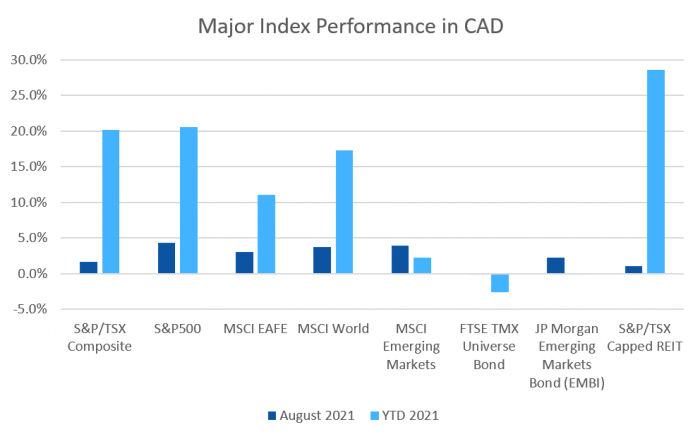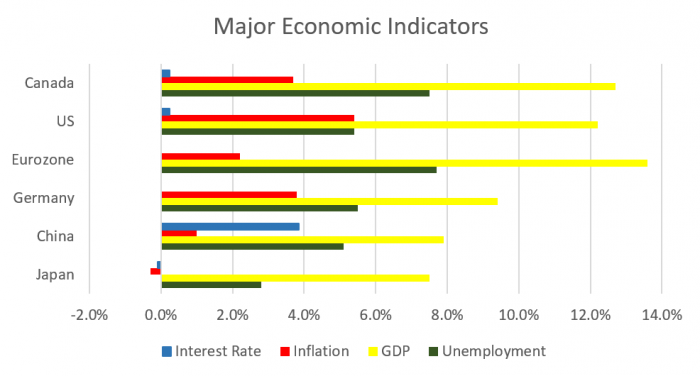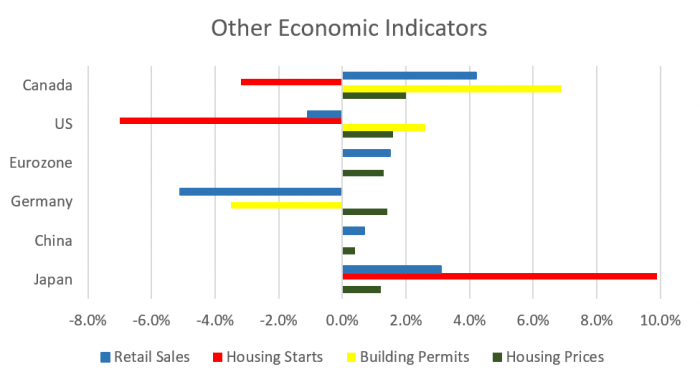August was the seventh positive month in a row for most equity markets, while bonds were mixed. REITs were once again positive, their eighth consecutive positive month.
August 2021 Market Performance
All index returns are total return (includes reinvestment of dividends) and are in Canadian Dollars unless noted.
| Other Market Data | Month-end Value | Return for August 2021 | 2021 YTD Return |
|---|---|---|---|
| Oil Price (USD) | $68.50 | -7.37% | +41.18% |
| Gold Price (USD) | $1,818.10 | +0.05% | -4.06% |
| US 3 month T-bill | +0.04% | -0.02%* | -0.05%* |
| US 10 year Bond | +1.30% | +0.06%* | +0.37%* |
| USD/CAD FX rate | 1.2617 | +1.24% | -0.90% |
| EUR/CAD FX rate | 1.4906 | +0.80% | -4.50% |
| CBOE Volatility Index (VIX) | 16.48 | -9.65% | -27.56% |
*Absolute change in yield, not the return from holding the security.
August was the seventh positive month in a row for most equity markets, while bonds were mixed. REITs were once again positive, their eighth consecutive positive month.
The S&P/TSX Composite was up +1.6% in August, and hit new all time highs. The TSX Comp. is now up more than 20% for 2021. The S&P/TSX Small Cap was flat for August. In the US, the large cap S&P500 was up +3.0% (+21.6% for 2021), and the small cap Russell 2000 index was up +2.1% for August. The tech focused Nasdaq was up +4.0% for the month, and is up +18.4% for 2021.
The broad index of EAFE (Europe, Australasia & Far East) stocks was up +2.0% (+13.8% for 2021), European stocks were up +1.9%, and British stocks were up +1.2% in August. For 2021, European and British stocks are up +16.5% and +10.2%, respectively. Japanese stocks were up +3.0%, swinging positive for 2021. Emerging market stocks were up +2.1% for August and are now up +2.1% for 2021 (that’s not a typo).
Bonds were mixed in August. The major Canadian bond index, the FTSE/TMX Universe Bond Index, lost -0.1% in August while the FTSE/TMX Short-term Bond Index was up +0.1%. Both are still negative for 2021; -2.6% for the Universe index and -0.1% for the Short-term index. US investment grade bonds also declined; both the ICE BoA AAA and BBB indexes lost -0.2%. High yield was up +0.4% for HY Master II and +0.7% for the CCC and lower (the real junky stuff) Index. Emerging market bonds were up +2.2%, bringing the YTD loss up to -0.1%.
REITs continued their run, gaining +1.1% for August, and 28.6% for 2021.
Oil lost -7.4% in August, dropping back under US$70 a barrel. Gold was flat for the month. The diversified Bloomberg Commodities Index lost -0.3% in August, and remains up +23% for 2021.
In August, the Canadian Dollar (CAD) lost -1.2% against the US Dollar and -0.8% against the Euro.
August 2021 Economic Indicator Recap
Below are the readings received in August for the major economic indicators: central bank interest rates, inflation, GDP and unemployment.
Below are the current readings on a few other often followed economic indicators: retail sales and housing market metrics.
A Closer Look at the Canadian Economy
Canada’s unemployment rate dropped to 7.5% in July as most regions substantially eased COVID-19 restrictions. The economy gained 94,000 jobs, 83,000 of which were full-time jobs and 11,000 were part-time jobs. Interestingly, private sector employment gained 123,000 jobs, while the public sector shrank by 31,000 – perhaps due to closing of vaccination sites as the majority of Canadians received the second dose of the COVID-19 vaccine?
Housing prices across Canada were up +2.0% in July. The monthly price gains are slowing; June was +2.7% and May was +2.8%. Gains were led by again by Ottawa (+3.7%), followed by Halifax (+3.0%), and Montreal (+2.5%). For the fifth consecutive month all 11 major markets were positive. With the federal election campaign underway, expect the major political parties to announce plans to tackle the housing affordability crisis. Unfortunately, if they’re all like the Liberals’ plans, don’t expect any price declines in the near future, quite the opposite in fact.
The level of new housing starts declined -3.2% to 272,200 in July. Urban housing starts declined -0.7%, due to a decline of -3.1% in multi family urban home construction. Single family home constriction declined -7.1%. Building permits rose +6.9% in June to $10.3 billion, with seven provinces contributing to the gain. Residential construction rose +9.1%, led by multi-family construction in Toronto and Hamilton. The non-residential construction sector gained +2.2%.
The inflation rate for July was +0.6%, and +3.7% on an annual basis – the highest annual inflation rate since May 2011. Core inflation which excludes more variable items such as gasoline, natural gas, fruit & vegetables and mortgage interest was +3.3%. The rise in inflation was attributed mostly to gasoline and housing prices. Excluding gasoline, the inflation index rose +2.8%.
Retail sales were up +4.2% in June, and +6.2% compared to a year ago. Clothing stores led the charge with a gain of +49.1% (!), gasoline sales rose +6%, and car dealers saw a +2.7% gain.
Canada’s GDP was up +0.7% in June, with 15 of 20 industrial sectors showing expansions as manufacturing and services sectors rebounded.
As expected, the Bank of Canada left its benchmark interest rate at 0.25% at the July 14th meeting. The benchmark interest rate is expected to remain at its current low level until into second half of 2022. The BoC reduced its quantitative easing program of purchasing government and corporate bonds to $2 billion per week, down from $3 billion. The next meeting was scheduled for September 8.
*Sources: MSCI, FTSE, Morningstar Direct, Trading Economics



